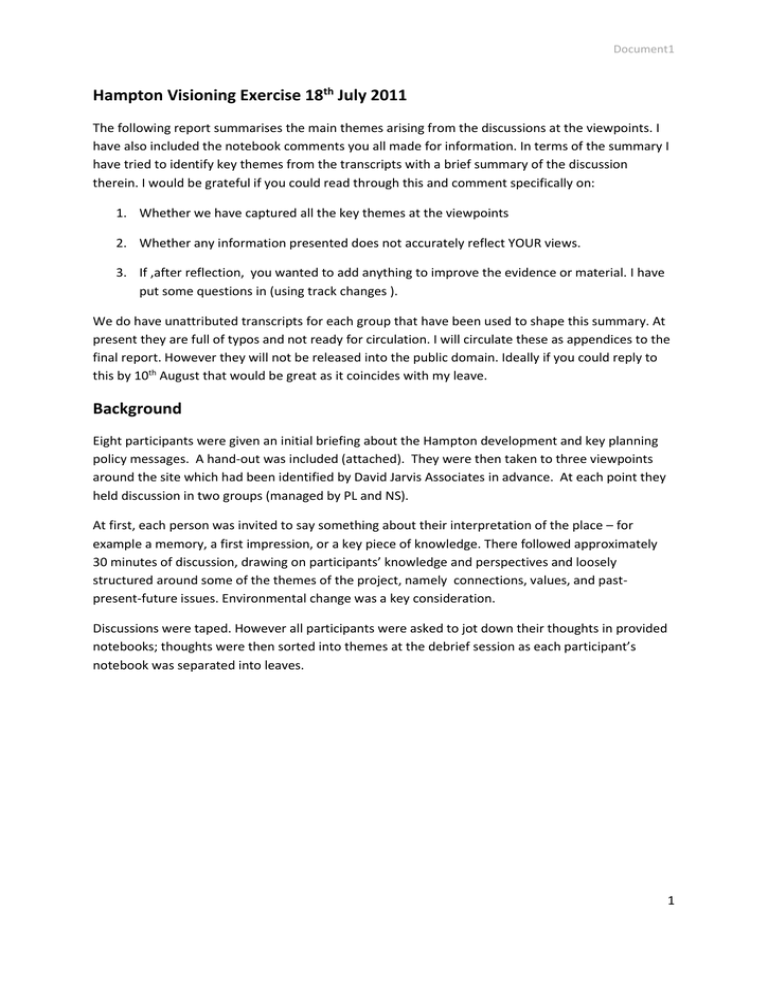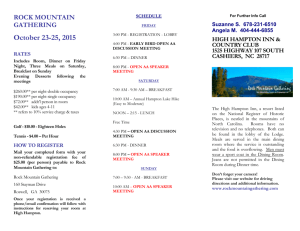Hampton Visioning Exercise 18 th July 2011
advertisement

Document1 Hampton Visioning Exercise 18th July 2011 The following report summarises the main themes arising from the discussions at the viewpoints. I have also included the notebook comments you all made for information. In terms of the summary I have tried to identify key themes from the transcripts with a brief summary of the discussion therein. I would be grateful if you could read through this and comment specifically on: 1. Whether we have captured all the key themes at the viewpoints 2. Whether any information presented does not accurately reflect YOUR views. 3. If ,after reflection, you wanted to add anything to improve the evidence or material. I have put some questions in (using track changes ). We do have unattributed transcripts for each group that have been used to shape this summary. At present they are full of typos and not ready for circulation. I will circulate these as appendices to the final report. However they will not be released into the public domain. Ideally if you could reply to this by 10th August that would be great as it coincides with my leave. Background Eight participants were given an initial briefing about the Hampton development and key planning policy messages. A hand-out was included (attached). They were then taken to three viewpoints around the site which had been identified by David Jarvis Associates in advance. At each point they held discussion in two groups (managed by PL and NS). At first, each person was invited to say something about their interpretation of the place – for example a memory, a first impression, or a key piece of knowledge. There followed approximately 30 minutes of discussion, drawing on participants’ knowledge and perspectives and loosely structured around some of the themes of the project, namely connections, values, and pastpresent-future issues. Environmental change was a key consideration. Discussions were taped. However all participants were asked to jot down their thoughts in provided notebooks; thoughts were then sorted into themes at the debrief session as each participant’s notebook was separated into leaves. 1 Document1 Viewpoint 1 Notebook comments Road adoptions? Mid-way through development/construction – not completed Unfinished Hampton Leys – different landscape character Feels a bit desolate (probably because of the weather) Very different from other areas in Peterborough Heritage of the site and its importance to the brick industry Unclear history/look of this area – no evidence of brick-making history Established/maturing development vs undeveloped post-industrial land Contrast between old and new Large green spaces/dense housing. Bland short grass areas. Hargate has more attractive layout. Economically driven Boundary – landscape and development Downgrading of A15? Street lighting? Low energy? But very attractive nonetheless Hard edge – long line of housing fronting entrance road. An evolving landscape Young mixed tree coppice A slow recovery Importance of connectivity New community Need to build community cohesion between 2 developments Boundary/zone of transition. [this is] Current edge of RUF Road – throughroad – transit Unconnected landscape features Lots of on-street parking – cluttered look Great new road link Future: Problems for cycling and walking to school from Leys to Vale. Careful consideration for safe routes to school and PCC school transport policy Walking and cycle links? Particularly from Leys to Vale for secondary Viable cycle link? Connections – people, places, wildlife. Local and regional/city wide Bus links along A15 and bus stops? How accessible are these for the developments? Where will they be? Parking Pressure Easy cycle ride to city centre and other sites within development – ie Serpentine Green Centre. Therefore good links to cycle network is important. Bus Route? And associated infrastructure Influx of social housing to 20% from 15% Lack of connectivity for cycle routes/car-use focus Poor connectivity between H. Leys and H. Vale schools for people Car clubs to reduce car ownership Lots of on-street parking 2 Document1 Lots of street parking Restricted parking spaces Integration through connections, but only within Hampton. There is a distinction between Hampton and Peterborough Connections are key for both nature and people More open space in Hargate giving a softer more pleasant environment (en route 1>>2) (en route 1>>2) houses less dense, more greenspaces, more mature (en route 1>>2) Church site is coming end of this year. No plans for a mosque. The Plan said one non-Christian place of worship (en route 1>>2) (en route 1>>2)plenty of green space The following themes emerged across the groups. 1 Connections and barriers The development in Hampton Leys was seen as very much something waiting to happen. The harsh edge was apparent given the boundary of the A15 which was a huge barrier to the development space in Leys. This was also going to be a major psychological and natural barrier for cross boundary movement whether it be for schools, facilities and other social events where shared facilities were going to exist. It was also highlighted that this was an environmental and landscape barrier. Particular issues revolved around the viability of the walking to schools initiative. It was going to be important to build connections (even a real bridge) to improve connectivity and cohesion between the 2 communities. There was concern that an original proposal to significantly downgrade the A15 (to bus only) had been dropped and this busy road would only serve to heighten the barrier between the 2 communities. This would generate further problems for on-street parking pressure of the road on which we stood when the junction becomes operable with substantial traffic increase likely. This will change the character and feel of an area at peak times of the day with ad hoc temporary parking for dropping/collecting pupils at the 2 schools/College. One major issue revolved around the huge success of attracting young families around here which led to increased demand for facilities and services not originally envisaged. This posed real strains on infrastructure. 2. The Hampton masterplan There was recognition that the developed area was quite densely packed with housing (3 storeys). The influence of a change in national policy driving the development was key to this increase in density. The requirement for 20% affordable housing also contributed to a change in the character of diversity, negatively in some parts. It was felt that, on the whole, the development was quite attractive and diverse in terms of housing stock and styles and integration with greenspace evident and valued on one side of the road. There was definite scope for improved biodiversity however, rather than just tightly managed and mown greenspace. 3 Document1 There was a tension apparent between the way the section 106 agreement provisions were triggered, with on the one hand the developer happy that numbers of completions were the trigger as opposed to the community who felt that they needed particular community facilities now. The example of the primary school and meeting spaces were cited. The other elements such as café culture small areas and leisure centre and meeting spaces (via college) had seemingly not come to fruition. 3. Hampton Leys vs the other Hamptons Discussion identified that Hampton Leys will be different in character to the other Hampton development areas as there is already green Infrastructure (mature trees and woodland) in situ. This could give the development a distinctive personality. The issue of national policy as a straightjacket on development was previously identified as something that had impacted negatively upon the nature of some aspects of the development. The other Hamptons had been developed on an old brick works site and were essentially all carved out on a blank canvas. It was identified that there was an important heritage opportunity to give residents a sense of place and identity from the previous manifestation. This is achieved in Hampton Hargate through the Tump, which helps to illustrate the topographical history of the site. It was suggested that the historic heritage of the site could also be illustrated by on site interpretation boards showing before and after photos of the brick landscape, as well as a panorama panel at the top of the tump pointing out key landscape features. 4. Planning Hampton and the car Discussion identified the way car ownership and behaviour was causing negative impacts in terms of chaotic parking on streets particularly at certain peak times. Car use and ownership was deemed excessive but there was still a cultural problem concerning the widespread use of public transport. A need for greater primacy for pedestrians and buses was supported along with a sustainable transport policy and plan. The chief problem appeared to be the high percentage of unadopted roads which limited the use and enforceability of parking restrictions. The issue of the downgrading the A15 also was cited as a missed opportunity. It appeared that some areas were better connected via public transport than others. The use of walkways and cycle routes within the development was praised but there was concern at the limited connections made outwith the site particularly to Peterborough and other recreational sites. 5. Environmental opportunities and environmental change There was recognition that a lot of green space was visible, both formal recreational and open space for biodiversity. Both types were thought of as important, 4 Document1 The potential for flood risk on development sites was seen as a major problem for the future but the SUDS system at Hampton utilises a whole suite of ponds and lakes to provide a proactive response. There was some concern by the owner of the site that any change to the agreed SUDS plan agreed in advance would result in delays to the scheme and because of this opportunities for site enhancement had been missed. Viewpoint 2: Notebook comments Tump a huge asset Linkage to proposed Great Haddon Great view of development [from up here] Panoramic views N, S, E, W. Green features on all horizons Green roof on school Green roof School roof is very impressive Much less dense here Less dense reflecting change in approach Green Too much amenity grassland? Greenspace for people rather than wildlife Feel like in countryside Lots of greenspace Open interesting feature Good cycle/path network. Nice avenues of trees which will mature Not much traffic Nature reserve very separate. Not welcoming/not explained or interpreted to residents. Historic perspective? Child friendly Fringe of Peterborough or fringe of London? Or is Hampton a place with its own fringe? Housing – plenty of variety. Hard to tell which is social and which is private Traditional feel/look. Only one green roof. No solar panels. Old > New. Established > Young Shift from open Hampton Vale to denser communities between viewpoints 1>2) Too self-sufficient.contained? Everything on Hampton’s doorstep? Flood prevention Beautiful water areas (en route 2>>3) Wildlife on lakes (en route 2>>3) Contrasting SUDS ponds You’d never have got this amount of open space and water if it wasn’t for the drainage and the designations The following themes emerged 1. The tump as a community landmark The discussion identified this feature as an important landmark in the whole Hampton development. Afforded good views and there was recognition about the need to put something here but with that lay the issue of its future management as well as issues of 5 Document1 ‘access to all’. The issue of heritage and sense of place and identity was talked about and it was felt that the community should take ownership of the space. Recognised that the space was valued in its present form which suggests that the status quo may not necessarily be ruled out as a valued informal space. 2. Capacity and availability of community facilities and infrastructure The discussion focussed on the primary school and its success in enrolments resulting in it being too full to accommodate all Hampton residents with some being taxied out to neighbouring schools. Whilst there was an extension to this school it was felt that there needed to be better planning given the central role of the school in the community. Interestingly this issue also cropped up with office business use being allowed to change to other uses (retail/restaurant) when they had failed. The need for planners to have flexibility to changing circumstances was stressed and appreciated. The lack of a meeting place was also highlighted. The primary school had a small meeting room for 30 people for 5600 residents. The College was designed and built with enhanced spaces and additional features, such as a 200 seat amphitheatre, to be the centre of the community however this has not materialised due to its management The new large hall and community centre in Vale neighbourhood will help to address some of these issues. It was felt that the current limit on community infrastructure was having an important disconnect. A theatre club for example had to go outside Hampton to function. This raises a key issue of how community infrastructure much should be provided within the boundary of Hampton and how much should be provided in the centre (Peterborough). Some emerging views that there was a need to look out. 3. The restricting of access to the nature reserve The partial fencing of the nature reserve at the request of Natural England was seen as a very important disconnect between the people, the community and place. It was as if a major element of the site had become separated from the green infrastructure. There was support for better understanding/interpretation of the value of the reserve (real lack of awareness) ; some improvement of access along designated boardwalks all building towards an improved sense of community pride in what was there. There seemed to be a divide between the more managed greenspace for the community and the protected nature reserve which was excluded due to its extreme ecological sensitivity. 4. The Changing nature of Hampton Community and its fringe(s) 6 Document1 The discussion revolved around the extent to which Hampton was on the fringe of Peterborough as well as the fringe of London. Given that it was 45 minutes by train raised the prospect of cheaper house prices and better quality of life. The community was increasingly diverse attracting people from London, Peterborough and elsewhere. Role of commuters increasingly important in Hampton and it was clear that the estates were creating a complex pattern of relationships within and across the region not just for Peterborough. One problem identified was the length of time to get into Peterborough (station) from Hampton and whilst a direct bus had been provided this had not had good uptake and was dropped. Support was given for a train link at Hampton but it was seen as an unrealistic demand on infrastructure. It was commented that some areas of Hampton development have done really well with formal play space and football fields and astro turf whilst other areas are in deficit. However it was stressed that Hampton was just one part of Peterborough fringe and there was the need to see the connections with the Great Haddon where 5000+ new homes are subject to a current planning application and new industrial land is being developed to augment employment opportunities in Hampton. Little clear identity to the community here through a particular industry or land use. Availability of allotments but given small size of gardens the demand was easily going to outstrip supply. Felt that a larger scale community venture might be something to give community cohesion. 5. Environmental Change Importance of the trees planted here maturing and giving the community cover and different layers of green space. The way the fringe will change in the future with Great Haddon being the new urban rural fringe. There was discussion about the prospect for renewable power with solar panels but concern over the visual impact and the fact that it is not built into the design itself. Not seen as something the planning system could enforce. There would have to be stronger national policy here. The green roof was seen as something that could be used within the community and there was hope that various community infrastructure and some identified self-build eco homes could lead the way in renewable activities. However currently this was all limited. 7 Document1 Interestingly noticed that dog mess was an issue here; need for greater enforcement and or greater responsibility by dog owners given the number of children in the area. Viewpoint 3 Housing very dense – needs more green/trees Fantastic area for a country park Green Space. Brown Space. Attractive views to south, away from Hampton. “English Countryside” Wind Farm People vs wildlife Will be a great place to live Connections between Great Haddon and Hampton. Improve cycling/walking. Boardwalks/nature walks More positive promotion of biodiversity – great crested newts/stoneworts Green in the distance but housing in forefront looks very hard and bleak Wooded views south >> Yaxley Church “Naturally wild” [here is ] Current RUF boundary - but will be Great Haddon on the south side Very harsh, ugly edge of development. Doesn’t look finished. Bund (?) is a separation between urban and rural Hard edge – need to soften landscape into surrounding area Orton Pit forms boundary with housing Hard urban edge Importance of connectivity –people, landscape, wildlife Industrial park on far horizon to NW. Wind turbines and chimney to E. Beautiful views. Harsh moonlike environment The following themes were identified 1. The SAC as opportunity and barrier for Hampton Development It was felt that although the wildlife value (newts and stonewort) had acted as a significant brake on development and clearly had put extra cost and delay on the plan, however it was precisely this unique set of circumstances and the need for an innovative drainage system that had given Hampton its sense of place and high percentage of greenspace. Without the designation and a need for SUDS there was a clear consensus that there would have been much more housing. This raised the opportunity of improved communication and awareness about the outstanding nature conservation value of a site so close to a new community. There was 8 Document1 clear support for greater community involvement in the management of the site, and more use for educational purposes. The present site viewpoint did expose the harsh edge between housing and the reserve with no real buffer zone in evidence, although it was acknowledged over time that the bund we were standing on would become a green linear feature in the landscape once it had been colonised. The present close proximity bounded by the road magnified the conflict between people, cats and the wildlife through disturbance and interaction. Issues of water quality was extremely important here and the need to have two separate systems was key to protecting the integrity of the wildlife habitat. 2. Peterborough versus Hampton A clear tension was identified between some developments in Hampton which were impacting on the viability of Peterborough as the major retail centre itself. In particular the Tesco’s store was seen as a development taking people away from Peterborough as a retail destination but significantly they were not going in to Hampton. It was recognised that Hampton residents benefited greatly from the superstore. However it was lamented that promised smaller shops in a café style culture had never been realised. This perceived competition was also limiting the development of other facilities such as a gym and other shops and facilities. It was important here to both look out of Hampton to Peterborough rather than create everything in situ. 3. Connections out to countryside and elsewhere The Hampton development was not separate from the surrounding area. Indeed the Great Haddon development would be linked in and improved connectivity needed to exist between the 2. In this context the economic development was important as new employment opportunities would be created in Great Haddon which could also help sustain Hampton and vice versa. Discussion focussed on the need to make more connections to places outside Hampton turning attention outwards rather than inwards. Here opportunities to link with other recreational destinations were identified with some encouraging developments already under way as for example in the Peterborough Green Wheel 40 mile cycle route around Peterborough which connects the whole fringe and Great Fen with feasibility work to establish walk/cycle routes from Hampton, for example. There was also a need to look strategically at identifying, signposting and publicising spaces for activities as people did not know that there are a good number of other nature reserves 9 Document1 and Crown Lakes Country Park close by. The current fence was seen as an incentive for some people to trespass and cause damage but could also indicate a lack of formal play activities. Given the high percentage of young families in the area there was a real concern to provide activities and space for teenagers in the future to stop anti-social behaviour. The need for BMX, skateboarding and other formal recreational space was seen as key here. Kids needed a range of places to play. All of this was seen to help build community cohesion and pride. 4. Maximising the green opportunit (ies) The whole development was seen to be really good and green and whilst access was not allowed to the reserve it was key and possibly unique to the setting. It was a green development. The bund area was a key space for colonisation by native species but because of this it was going to take much longer for the area to green up. The slope was also composed of crushed bricks which further hindered growth. However it was deemed better to have native species present rather than alien plants. In time this area would become a linear buffer between the nature reserve and the housing development. It was noted that the gardens of houses were very small and it was important to secure appropriate trees within the development. Again an idea was to give households more information about what suitable trees they could plant to benefit the area in the long term. The idea of allotments was discussed and supported. Some small scale provision was already included but there was support for a larger community type area and to build this into development processes more generally. 5. Environmental change The issue of sustainable travel was also raised set within the idea to have more bus routes. Wind farms and other renewable developments were discussed particularly solar. The issue was repeated that there is limited amount of housing or industry currently using such aspects but it was felt that they would improve in the future. To do this it was felt that these type of development needed stronger policy leads. 10 Document1 The role of trees was seen really important in mitigating the impact of climate change but also enhancing the liveability of the area as lessening urban heat islands was also important. 11




